Nikon COOLPIX A review
-
-
Written by Ken McMahon
Intro
The Nikon COOLPIX A is a compact camera with a large APS-C sensor and a fixed 28mm equivalent f2.8 lens. Announced in March 2013 and aimed squarely at enthusiasts, Nikon claims it’s the World’s smallest camera to feature an APS-C sensor, the same size as those in the company’s range of DX-format DSLRs. It also offers 1080p video, full manual control, 4fps shooting, a hotshoe and supports optional GPS, Wifi and optical viewfinder accessories.
The COOLPIX A sensor has 16.2 Megapixels and, like the Nikon D7100, dispenses with the optical low pass filter for sharper results, albeit at the risk of increased moire. Nikon’s argument for the D7100 was that its 24 Megapixel resolution easily out-resolved the most common patterns which could trigger moiré, but clearly the COOLPIX A proves the company believes 16 Megapixels is sufficiently high to avoid it too.
Nikon has also optimised the micro-lenses on the sensor to work with the fixed wide angle lens to minimize light fall off in the corners. The lens itself has a focal length of 18.5mm (28mm equivalent) and a focal ratio of f2.8. An optional adapter supports the use of 46mm filters and a lens hood. The lens extends during power-up and features a built-in cover like a point-and-shoot model.
The COOLPIX A is possibly the most compelling argument yet for a fixed lens compact camera that shares not only the manual control of a DSLR, but matches the image quality that can only come from a larger sensor. But this is a growing market and there’s no shortage of competition with models from Sony, Canon, Fujifilm and Olympus all looking to tempt enthusiasts. Arguably the closest rival to the COOLPIX A is Fujifilm’s X100S and I’ll be comparing their quality as soon as I can get them both next to each other at the same time. For now though I thought it would be interesting to see how the COOLPIX A compares against an enthusiast compact with a smaller sensor. The Olympus XZ-2 may not have the big APS-C sensor, but it does have a 4x zoom with stabilisation, a flip up touch-screen and the chance to fit electronic viewfinder accessories, all at a lower price. So which type of camera will be better for you? Read our full review to discover which came out on top, and check back soon for more X100S comparisons.
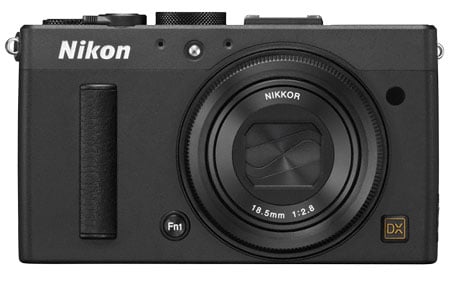 |
Nikon COOLPIX A design and controls
The COOLPIX A is rectangular block of a camera that comfortably fits in the palm of your hand. With an aluminium alloy chassis and magnesium alloy top plate it’s strong, and feels capable of withstanding a few knocks. I reviewed the black model which looks as well as feels like a serious camera, but it’s also available in silver.
Measuring 111 x 64 x 40mm it is undeniably small considering it has an APS-C, or as Nikon calls it a DX sensor at it’s heart. It doesn’t quite manage the pocketability of COOLPIX point-and-shoot compacts, but it’ll comfortably fit in a coat or jacket pocket. The integral lens cover, which automatically closes when the lens retracts adds to its portability – you don’t have to worry about replacing it or getting the lens scratched before stuffing the camera into a bag or pocket, just power off and you’re done.
At 299 grams it’s comparatively lightweight, but still has a reassuring heft to it. It’s both lighter and smaller than the Olympus XZ-2, but place the two of them side-by-side and there’s not a lot of difference to look at them. The XZ-2 measures 113 x 65 x 48mm and weighs 346 grams with battery and card, so the only significant size difference is in the depth – the extra 8mm is due to the XZ-2’s flip-up screen. The XZ-2’s lens barrel also extends a little further at the front, but that’s because it has a 4x zoom compared with the 28mm (equivalent) fixed prime on the COOLPIX A.
The Fujifilm X100S is arguably the prime competitor for the COOLPIX A. It’s a fixed lens compact with a big sensor, in fact the same sized sensor with the same resolution as the COOLPIX A, although with a different colour filter array. The X100S, like other models in Fujifilm’s X series, emulates the styling of the rangefinder models of the late 20th century. As such, it includes an optical viewfinder, but with a modern twist, hybridizing it with an LCD overlay and a fully electronic alternative. The X100S measures 127 x 74 x 54mm and weighs 445 grams with card and battery, a good bit wider taller, thicker and heavier than the COOLPIX A, but with not one, but two viewfinders compared with none on the COOLPIX A.
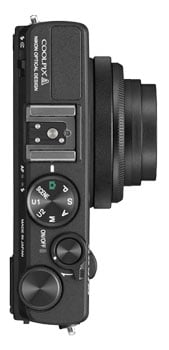 |
The COOLPIX A may well be the World’s smallest camera to feature an APS-C format sensor, but the compromises involve no viewfinder, a fixed focal length lens and a fixed LCD screen. Those things needn’t be hugely disadvantageous, many people would opt for portability over an articulated screen, while a fixed prime can arguably be a better choice than a short zoom and there’s also an optional optical viewfinder that fits in the hotshoe. But at this stage in the review, I’m already wondering if Nikon hasn’t sacrificed a little too much for size.
The first design feature I want to talk about on the Nikon COOLPIX A is the on/off switch, because it’s unusual and also because from the first time I used it I fell in love with it and wondered ‘why aren’t all compact camera on/off switches designed this way?’ It’s a collar switch around the shutter release with a short lever that extends outward to the right, parallel, but just behind the front edge of the top plate. To activate it you push it back with your index finger, then release it, letting it spring back to its original position and it’s the same procedure to turn the camera off. What’s great about is that it’s so much easier to operate than the usual buttons and switches. There’s a small green LED behind it to indicate the power’s on, which flashes when the camera goes into power-off mode.
Behind and to the right of the shutter release is the command dial. It protrudes a little from the rear panel so you can operate it with your thumb. It’s used mainly for exposure control in the PASM modes, I’ll talk about it and the other controls in more detail in the handling section below. On the other side of the shutter release is the mode dial with PASM positions, two custom positions U1 and U2, a SCENE mode position and Auto.
Moving further left is the standard hotshoe with a (very tight fitting) cover and beyond that on the front left corner of the top panel is the pop-up flash which is activated by a mechanical catch on the narrow bevelled top section of the rear panel. The only other things on this angled edge are two LED’s – an AF indicator and flash ready light. Given that AF lock is indicated both on the screen and by a beep I assume the LED is for visual confirmation when you’re using the optional optical viewfinder.
Moving onto the rear panel, the left side of the screen is given over to a column of four buttons , exposure compensation, ISO/Fn2, and two magnifier buttons, the second of which also activates the help.
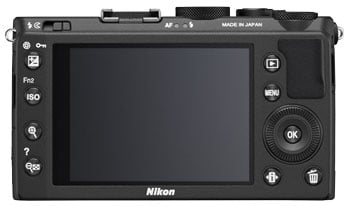 |
On the opposite side of the screen at the top is the playback button and below that the menu button. Then below the rear control wheel or ‘rotary multi selector’ as Nikon likes to call it are the delete button and the i button for displaying and editing camera settings.
On the top right corner of the rear panel a large rubber-like thumb pad provides enough of a grip to allow you to shoot confidently holding the camera in your right hand only, with your second and third fingers wrapped inside the leather-effect grip bar that runs almost the length of the front panel. The Olympus XZ-2 has a similar arrangement, but with a more substantial removable grip. Between the bar and the lens at the bottom of the front panel is the other Fn button – Fn1. On the opposite side of the lens is a gold DX badge – if you’ve got it, you may as well flaunt it – and above it near the top an IR receiver for the remote control. A narrow seam separates the top front panel section above which is the AF illuminator light flanked by the stereo mics. Finally on the top left corner (as you hold the camera) is the distinctive white Nikon badge. It all adds up to quite an attractive, professional and sophisticated looking package.
The COOLPIX A has a mini HDMI port on the upper right side of the body and on the opposite side you’ll find a USB 2 port, compatible with Nikon’s Wu-1a Wi-fi dongle, and an accessory port compatible with the GPS-1 GPS receiver; it’s nice to support these accessories, but nicer to have them built in. On the same side at the bottom front edge is a three-way switch for selecting AF, Macro and Manual focus modes.
The COOLPIX A takes the same EN-EL20 battery, rated at 1020mAh, as used in the Nikon J1 system camera. The J1 manages 230 images from the EN-EL20 and it’s exactly the same on the COOLPIX A, you’ll get 230 images under CIPA conditions or one hour and ten minutes of video. That’s on the low side for enthusiast cameras and meagre even compared with many basic compacts. The Olympus XZ-2 will let you shoot 310 images and the Fujifilm X100S pushes it a little further with 330 shots. The bottom line is that for anything other than casual use, you’ll probably want to carry a spare battery.
The battery charges in an external charger, which means that, providing you’re within reach of a power outlet you can charge a depleted battery while using your spare. The MH-27 charger is the type without a cable that plugs directly into a wall socket- so there’s less to carry around than with chargers that have a lead. Back in the camera, remaining power is indicated by a three-segment graphic in the bottom left corner of the screen, but the COOLPIX A lacks detailed battery information of the kind available on some Nikon DSLRs.
The COOLPIX A has a built-in flash situated at the front of the top panel on the left corner. It doesn’t raise automatically, even in auto mode, but is released using a small sliding catch on the top section of the rear panel just behind it. When you’re finished with it you gently push it back into the camera body. The flash has a quoted range of 11.5 metres which sounds impressive until you realise that’s in auto mode with auto ISO, so it’s probably at the maximum 6400 ISO. At lower ISO settings that figure will obviously reduce. A more useful figure is the Guide Number which is 6 (metres, 100 ISO) indicating a range of just over 2 meters at 100 ISO at the maximum f2.8 aperture.
If you need more power you can fit a larger external flash to the COOLPIX A’s hotshoe, and the COOLPIX A’s built-in flash can also be used for wireless control of external units. The hotshoe can also be used to fit Nikon’s optical viewfinder accessory.
Nikon COOLPIX A screen
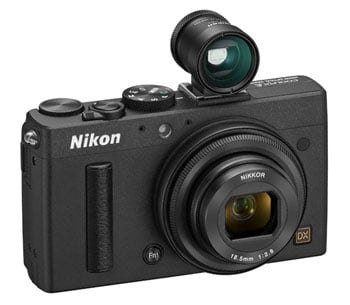 |
Though the COOLPIX A lacks a built-in optical viewfinder, there is an optional optical viewfinder accessory. So if you love everything else about Nikon’s advanced big-sensor compact, but can’t live without a viewfinder, this might be the answer. The DF-CP1 optical viewfinder attachment is available in matching black or silver and fits into the hotshoe. There are no electronic connections, it’s purely optical and provides a view slightly wider than the 28mm lens coverage with markers to indicate the 100 percent image area. I didn’t test the COOLPIX A with the DF-CP1, but as one of those people for whom a viewfinder of some sort is a must, if I were buying the COOLPIX A I’d be buying the DF-CP1 too. Then again, the price – nearly half the cost of the camera itself will put many people off.
If you want to add a viewfinder to the Olympus XZ-2 you have the choice of two electronic models, the best of which boasts a resolution of 1.4 million dots and costs less than the COOLPIX A’s optical attachment. And the Fujifilm X100S boasts a hybrid optical / electronic viewfinder with a 2.35 million dot LCD.
If you baulk at the cost of the optional optical viewfinder, you’ll be exclusively using the COOLPIX A’s 3-inch 921k dot LCD screen to compose and review your shots. It’s an excellent screen which displays a punchy, saturated, slightly cool image. The brightness is adjustable, but it works well in most situations at the default brightness level. If you can’t see very well due to bright sunlight, adjusting the brightness probably isn’t going to help, and this is one of the COOPLIX A’s weakest areas. In the absence of any kind of articulation if you can’t see the screen your only option is to try and shield it with your hand. The Olympus XZ-2’s hinged touch-screen allows you to flip it up or downwards, which not only makes it easier to keep it out of direct sunlight, you can also position it for comfortable viewing when shooting from unusual angles.
Nikon COOLPIX A lens and stabilisation
The COOLPIX A is fitted with a Nikkor 18.5mm fixed focal length lens. The 1.5x field reduction of the DX sensor results in a full-frame equivalent focal length of 28mm. Were it the maximum coverage of a zoom lens, as on the Olympus XZ-2, a 28mm wide angle would be without doubt a great feature, but as a fixed prime you have to wonder whether Nikon hasn’t aimed a little wide of the mark. If you shoot landscapes and interiors almost exclusively you’ll love the 28mm lens and probably be prepared to put up with the fact that it’s not great for general use, is far from ideal for portraits and anything more than a few metres from the lens looks very distant.
If I was restricted to one lens and had a choice I think I’d prefer a 35mm equivalent, which would still offer useful wide angle coverage for landscapes, but be better suited to other kinds of photography. A slightly longer focal length would also have improved the COOLPIX A’s ability to render shallow depth of field at its maximum f2.8 aperture.
The Olympus XZ-2 also has a 28mm starting point, but with a 4x zoom you’re not restricted to that focal length, but can choose it for those subjects that warrant it, zooming in for portraits and more distant subjects. The Fujifilm X100s, like the COOLPIX A, opts for a fixed focal length prime but a 35mm equivalent much better suited to general purpose photography. It’s also worth noting that both the Fujifilm X100S and the Olympus XZ-2 sport brighter maximum apertures than the COOLPIX A at f2 and f1.8 respectively.
The wide focal length and proximity of the lens to the camera’s sensor provides technical challenges, most notably in the form of light fall-off at the edge of the frame, or vignetting. Nikon has overcome these problems with optimised micro lenses designed to capture light at acute angles. Nikon also claims to have minimised lens aberrations without the need for digital compensation. There’s no stabilisation, which is less of an issue on a 28mm equivalent lens that can be hand held for stills shooting at speeds of around 1/30. It’s absence is more of a loss for movie recording though which, unless you have a very steady hand, suffers from noticeable wobbles.
|
Removing the plastic front ring from the lens reveals a screw thread on which you can mount the UR-E24 adaptor ring which accepts 46mm filters or a lens hood. Further back there’s an 8mm wide ring which is used for manual focus adjustment. The action is very smooth and the ring is dedicated purely to focus – it lacks the click stops of the Olympus XZ-2 and can’t be used for exposure control.
A switch on the left side of the camera body is used to select AF, macro and manual focusing (though you can manually adjust the focus in any mode) and the closest focusing distance in macro mode is 10cm. That compares poorly with even many budget compacts and you won’t get great shots of, say, small insects, but it does allow you to get some close-up compositions with a shallow depth of field.
For portraiture the COOLPIX A’s 28mm lens is less than ideal, but if you position your subject close enough, keep the background reasonably distant, and choose the widest f2.8 aperture you can get passable results. Below are examples comparing the COOLPIX A and the Olympus XZ-2. For the initial comparison the XZ-2 is set to its 28mm focal length and both cameras are set to their maximum aperture. For the second comparison the XZ-2 is zoomed in to its maximum 112mm equivalent and I’ve moved back to produce the same framing. Interestingly, though the Olympus lens is more than a stop wider at 28mm its ability to produce shallow depth of field is compromised by the smaller sensor and, even at f2.8 the COOLPIX A produces better results with a slightly more blurred background. Zooming the XZ-2 to its 112mm focal length and moving back to produce similar framing produces a much better result though with improved framing and perspective and a less cluttered composition as well a more blurred background.
Nikon COOLPIX A |
Olympus XZ-2 |
Olympus XZ-2 | ||
 |  | 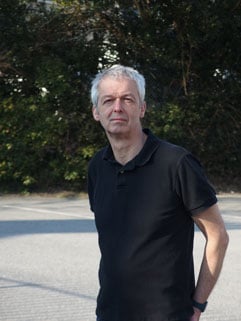 | ||
18.5mm (28mm) f2.8 |
6mm (28mm) f1.8 |
24mm (112mm) f2.5 |
Nikon COOLPIX A shooting modes
The COOLPIX A features fully manual and semi-automatic exposure modes, selected from the mode dial with the familiar P, S, A and M positions. There’s also an auto mode – indicated by the green camera icon – a single SCENE position for all the scene modes, and two user positions – U1 and U2.
People will be buying the COOLPIX A for its advanced shooting modes, but it’s reassuring to see a full auto position on the mode dial. Having said that, it lacks the Easy Auto mode with scene detection and automatic scene selection of other COOLPIX compacts; this is a straightforward Auto mode that simply meters the scene and selects an appropriate shutter speed and aperture combination. The main difference between Auto mode and Program auto is that the former activates face-detect AF if there are faces in the frame, turns on Active D-lighting and disables the command dial, which is used for Program shift in Program Auto mode.
In the PASM modes, the command dial is used to alter the exposure with the multi-selector wheel brought in for aperture control in Manual. Exposure compensation, up to a generous +/- 5EV, is selected using the Command dial while the Exposure compensation button is held down.
The COOLPIX A includes the Auto ISO sensitivity control feature included on recent Nikon DSLRs. When Auto ISO sensitivity is on the COOLPIX A will override your selected manual ISO setting if a correct exposure can’t be made. You can specify the maximum sensitivity and minimum shutter speed – for a fixed focal length lens pretty much a set once and forget operation. This is a great feature that gives you the best of both worlds – complete control along with a safety net for unexpected circumstances. If you’re shooting outside in Program Auto mode with the sensitivity set to 100 ISO then go inside, but forget to change the ISO, rather than a bunch of shaky hand-held long exposures, the COOLPIX A simply bumps the ISO up within your maximum limit so that you minimum shutter speed is maintained – automation at its best.
Another useful feature common to Nikon DSLRs that has been included in the COOLPIX A is the interval timer. This is such a simple, yet useful feature it’s surprising more manufacturers don’t include it, requiring you to buy an often expensive plug-in remote timer. The COOLPIX A’s timer works in the same way as on Nikon DSLR’s, you can choose the number of shots, the interval between them, and also delay the starting time if desired.
The COOLPIX A provides auto bracketing for exposure, White balance and Active D-lighting. All three options are restricted to 3 frames with up to 2EV in 0.3EV increments for exposure bracketing. Nikon consumer DSLRs aren’t renowned for their auto exposure bracketing, but for a compact the COOLPIX A does pretty well, better than the Olympus XZ-2 which also offers 3-frame exposure bracketing but only up to 1EV.
Finally, there are 19 scene modes, selected from a menu by rotating the Command dial with the Mode dial in the SCENE position. They include Portrait, Landscape, Child, Sports, Close-up and Night portrait. They provide a handy shortcut to good results for those who lack the experience to get the best results in all situations, but look increasingly anachronistic by comparison with models like the XZ-2 which offer an intelligent auto exposure mode with sophisticated scene detection built-in.
Nikon COOLPIX A movie modes
The COOLPIX A provides 1080p HD movie recording with a choice of 30, 25 and 24 frames per second, 720p recording is also available with the same choice of frame rates. Video clips are encoded at one of two quality settings: for the 1080p modes High quality encodes at a maximum 18Mbps and Normal quality at 10Mbps, for the 720p modes it’s 10Mbps and 6Mbps respectively with the exception of the 24fps setting which encodes at 8Mbps or 5Mbps.
Movies are encoded using the H.264 codec and saved as .mov QuickTime files. The maximum recording time for any quality setting is a second shy of 30 minutes and for the High quality 1080p30 mode is 20 minutes. The quoted bit rates appear to be on the conservative side; my 1080p30 test files were recorded at an average bit rate of 20Mbps with files sizes averaging around 170MB per minute of footage. Even so, 20 minutes of 1080p30 HD footage should easily fit on a 4GB card with room to spare.
The COOLPIX A has no dedicated movie record button and switching to movie recording is done via the drive mode menu, which pretty much rules out spontaneous quick recording. You can record in Program auto mode, alternatively selecting A allows you to adjust the aperture prior to shooting and in M mode you can adjust the ISO sensitivity as well as both the aperture and shutter speed, but not once recording has started. You can, however, adjust the exposure compensation by up to 2EV during recording by holding down the exposure compensation button while rotating the Command dial.
The COOLPIX A has no stabilisation, so you need a steady hand to avoid wobbles, as you can see from the hand-held examples below, even at a focal length equivalent of 28mm it can be a problem. There are two focus modes, AF-S which sets the focus for the entire clip when you half-press the shutter release and Full-time Servo AF (AF-F) which continues to focus during recording. The latter works very well as you can see from the example below.
| |
|---|---|
| |
| |
| |
|---|---|
| |
| |
| |
|---|---|
| |
| |
| |
|---|---|
| |
| |
Nikon COOLPIX A
handling
In PASM modes the COOLPIX A provides a comparable level of physical control to a DSLR; selecting and adjusting exposure using the Command dial is direct and straightforward, at least in Aperture and Shutter priority modes. Enlisting the multi-selector wheel for aperture control in fully manual mode also works well, though some people might prefer the kind of setup on the XZ-2 which has a dedicated lens ring for aperture control. But what you gain on the one hand with the XZ-2 you literally lose with the other as it has no equivalent of the COOLPIX A’s Command dial and therefore has to assign many more functions to its rear wheel. The Fujifilm X100S goes several steps further than either of them, with a dedicated aperture ring with marked f numbers, a dedicated shutter speed dial with marked shutter speeds and a dedicated exposure compensation dial, yes with marked EV values. So the COOLPIX A’s control layout works well, but if you’re one of those people who prefer physical controls to buttons and menus, there are better options out there.
The information display is fairly comprehensive, with the current shooting mode and a raft of other settings including drive mode, focus mode, AF-Area mode, Active D-lighting, Picture control white balance and picture size and quality arranged on an overlay across the top of the screen. Battery remaining and an icon to show that the audible beep is activated are displayed in the bottom left corner. Metering mode, exposure information ISO sensitivity, and remaining card capacity are displayed in a black band at the bottom of the screen. While it’s great to have all this information clearly displayed you don’t always need all of it and it would be nice to be able to turn it off or select a different, less cluttered overlay, but sadly that isn’t an option.
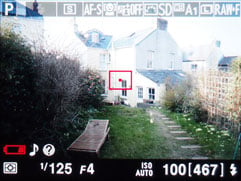 |
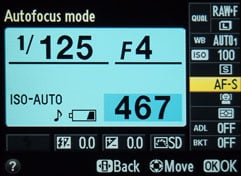 |
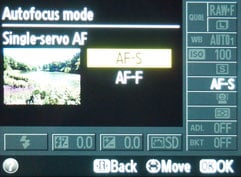 |
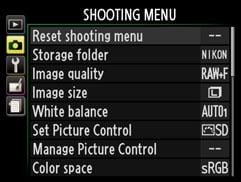 |
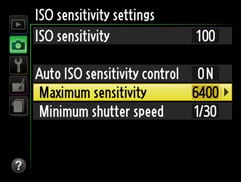 |
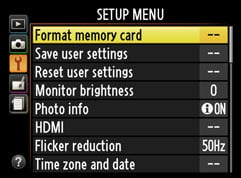 |
As with Nikon DSLR’s the COOLPIX A has an i button which activates the information display, replacing the live view on the screen but, as with the display overlay, the layout and appearance is fixed and can’t be changed. The main panel displays exposure information, battery remaining, beep indicator and remaining card capacity with settings arrayed down the right side of the screen and along to the bottom. To change something, you select it using the multi-selector, then press the OK button which takes you to a new screen with setting options.
Settings that have a dedicated button, like exposure compensation and ISO sensitivity, can be changed directly on the information display by holding down the button then rotating the Command dial. But you can do that without entering the information display and it would be far more useful to be able to change other settings, like drive mode, bracketing, white balance and AF-Area this way. You can’t do this on Nikon DSLR’s so perhaps it’s too much to expect it on the COOLPIX A, but you can do it on the XZ-2’s Super Control Panel.
Like the Information display, the menu system on the COOLPIX A follows a similar format to those on Nikon DSLRs, so if you’re looking for a compact alternative to a Nikon DSLR this too will be familiar territory. Like Sony, Nikon tends to organise menus as long lists, which I’m not a fan of but, on the shooting menu tab at least, there’s not a lot that can’t be accessed more easily from the Information display or elsewhere, so it isn’t that important.
Another thing that, regrettably makes the transition from Nikon DSLR’s is the paucity of playback information. The COOLPIX A tells you file name of a displayed image as well as the date and time and the image size and quality, but if you want the exposure information, other shooting settings or a histogram, you’ll have to wait until you can download the images.
Nikon COOLPIX A Autofocus
The COOLPIX A has two AF modes, Single-servo AF (S-AF) for stationery subjects and Full-time servo AF (F-AF) for moving subjects. These work in conjunction with four AF-Area modes, Face-priority AF, Wide-area AF, Normal-area AF and Subject-tracking AF. In Wide and Normal-area AF the position of the AF area can be moved around the screen using the multi-selector. In practice, the COOLPIX A’s AF is reasonably swift and accurate, in bright sunshine with contrasty subjects it acquires focus after a slight, but perceptible fractional delay. It’s not as fast as the Olympus XZ-2 and though I didn’t test it up against the Fujifilm X100S, with a quoted speed of .07s in good light it’s looks to be much quicker. So if fast AF is a priority you may be a little disappointed in the COOLPIX A’s AF. Having said that, for subjects like sport and wildlife that require fast AF the 28mm focal length is likely to prove more of a limitation.
If the AF can’t deliver the results you need, flicking the switch on the left side of the camera body switches to manual mode using the lens ring. Manual focusing is surprisingly easy using the 3 inch screen, particularly if you use the magnify button to zoom in. You can press it up to five times to get in really close which is good. What’s not so great is that you then have to press the zoom out button five times to get back to the normal view. It would be nice if the magnifier automatically kicked in when you moved the focus ring and automatically returned to the normal view when you half-pressed the shutter release.
Nikon COOLPIX A Continuous shooting
The COOLPIX A can shoot continuously at 4fps and has a buffer sufficient for up to 26 Large Normal quality JPEGs or 9 Large Fine JPEGs + RAW files. To test its continuous shooting performance I fitted the COOLPIX A with a freshly formatted 16GB Sandisk Extreme Pro UHS-1 SD card rated at 95MB/s. I set the picture quality to Large Fine JPEGs and fired a burst of frames in shutter priority mode at 1/250th. The COOLPIX A shot exactly 100 frames at consistent speed before coming to a halt and I measured the frame rate at 4.5fps.
Switching to RAW files, this time the COOLPIX A shot 18 frames before hesitating and slowing. The frame rate for the first 18 frames was the same as for JPEGS – 4.5fps before slowing to around 2fps.
All told this is a pretty good performance for the COOLPIX A and a little better than Nikon’s quoted figures. It’s roughly on a par with Nikon’s entry level D3200 both in terms of speed and buffer size, though slightly slower than the 5fps of the Olympus XZ-2 and 6fps quoted for the Fujifilm X100S.
Nikon COOLPIX A
Sensor
The COOLPIX A has a 16.2 Megapixel APS-C ‘DX-format’ CMOS sensor which measures 23.6 x 15.6mm. It’s the same size sensor as found in Nikon consumer DSLRs and indeed is widely reported to be the same sensor as in the old mid-range D7000. Like the newer D7100 though, the COOLPIX A dispenses with the optical low pass filter. On the D7100 Nikon’s reasoning was that its 24 Megapixel sensor resolution was high enough to make the filter redundant, so presumably that argument also applies to the 16 Megapixel sensor in the COOLPIX A. The low pass filter, also known as an anti-aliasing filter is there to eliminate moiré patterns caused by fine repeating patterns such as those found in textiles. But it also results in some blurring, so removing it can improve sharpness and resolution of fine detail.
In my tests the image quality produced by the COOLPIX A was, on the whole, excellent, though moiré was an issue in a small number of shots. Interestingly one of the main competitors for the COOLPIX A, the Fujifilm X100S also lacks an optical low pass filter, but it doesn’t need one due to the unconventional design of its colour filter array which differs from the Bayer pattern almost universally used by other manufacturers.
The ISO sensitivity range of the COOLPIX A is 100 – 6400 ISO with 12800 and 25600 available in the extended Hi1 and Hi2 settings. The shutter speed range is 30s to 1/2000 plus B. Images are saved as JPEGs in one of three quality / compression settings, Large Fine JPEG file sizes are typically around 4-7MB.
To see how the quality of the Nikon COOLPIX A measures-up in practice, take a look at my Nikon COOLPIX A quality and Nikon COOLPIX A noise results pages, browse my Nikon COOLPIX A sample images, or skip to the chase and head straight for my verdict.
 It may be that the COOLPIX A is one of those cameras that looks good on paper, but in the flesh requires too many compromises. But there are two things you can't argue with: it's compact and its image quality is unsurpassed. If that matters to you more than anything else and the fixed 28mm equivalent coverage works for your style of photography, it's a simple choice. It's certainly enough to earn the COOLPIX A our Recommended award.
It may be that the COOLPIX A is one of those cameras that looks good on paper, but in the flesh requires too many compromises. But there are two things you can't argue with: it's compact and its image quality is unsurpassed. If that matters to you more than anything else and the fixed 28mm equivalent coverage works for your style of photography, it's a simple choice. It's certainly enough to earn the COOLPIX A our Recommended award.




